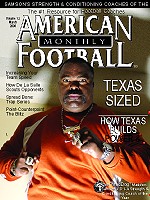AMERICAN FOOTBALL MONTHLY THE #1 RESOURCE FOR FOOTBALL COACHES
Article CategoriesAFM Magazine
|
Off Season Workoutsby: Danny Arnold© More from this issue Off-season training should take a different focus then your typical change of just changing the amount of reps. It should take a turn to pre-hab (exercises that help prevent or minimize injuries), technique, and individual or positional needs. In my past twelve years of really getting involved in NFL programs Iíve seen something that is a trend among strength coaches and athletic trainers that is very alarming. One of greatest concerns to me is how once the football season is over, the strength coach takes over the players development process and the athletic trainer hands off most (if not all) responsibility of player development to the strength coach. Although in most cases this is done because the athletic trainer has to now dedicate his/her time on to other sports that are beginning th....The full article can only be seen by subscribers. Subscribe today!
|
|
|||||||
| HOME |
MAGAZINE |
SUBSCRIBE | ONLINE COLUMNISTS | COACHING VIDEOS |
Copyright 2025, AmericanFootballMonthly.com
All Rights Reserved





